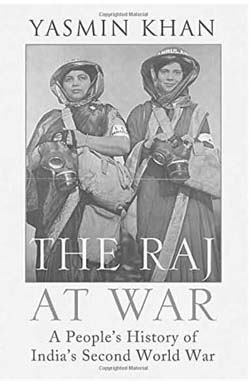The Raj at War: People’s History of India’s Second World War by Yasmin Khan, an Associate Professor of history at the University of Oxford and a winner of the Royal Historical Society’s Gladstone Prize, 2007, indeed justifies the prestigious award by being another magnum opus after The Great Partition. History from below was the project of subaltern historians during the 1980s, which was a paradigm shift in the study of history itself, by giving due attention to the excluded and marginalized voices and recognizing their important contribution in our society. The Raj at War does not claim to be one such text but it is written on similar lines.
The Second World War changed the dynamics of international politics, toppling the hegemonic colonizers from power and weakening their influence everywhere. It had equal consequences on the domestic politics of many would-be independent states. The British Raj was at war from 1939 to 1945. Its colonies provided foot soldiers, princes provided financial support and the entire British India was at war.
Japan’s assault was so strong in the East during 1940–42 that the fall of Empire seemed imminent. Singapore had already fallen and seeing the threat, the art of war demanded a quick response, which led the Raj to destroy crops and many other basic requirements of everyday life in the North East of India, culminating in infamous famine of Bengal. The moral support to the Raj in some quarters of Indian subjects vanished subsequently. Gandhi led yet another nonviolent movement across British India and demanded that they should Quit India.
The heartwrenching narratives in The Raj at War suggests that the War brought misery to the Indian subcontinent, and innocent civilians had to suffer for the cause of liberation of Europeans from the Axis Powers. Khan’s claim that ‘Britain did not fight the Second World War, the British Empire did’, is on scrutiny throughout the book, consistently documented by the contribution the non-expert civilians made to win the war for the Empire. Khan has highlighted the contribution of nurses, road builders, seamen, schoolgirls, Bengal famine victims, Nepalese, Burmese and Gorakhas.
Khan’s The Great Partition, which was about the creation of India and Pakistan, led her to probe the way war changed the fate of the Indian subcontinent. Before 1939, nothing was clear that the mission of the Muslim League would be fulfilled or not, or even whether India would get her Independence. For Jinnah, the war came as ‘blessing in disguise’ and shaped the debate and paved the way for Partition.
Midnight Furies by Nisid Hajari is the detailed account of India’s Partition analysing the historicity of the event on both sides of the cartographic divide. Hajari gives the detailed account of that how leaders from the Congress as well as the Muslim League manoeuvred for their share in the power structure as well as for territorial division. The current communal politics, the unresolved Kashmir issue and the role of RSS then and now, is all what we have gained from the Partition. The drawing of boundaries by Sir Cyrill Radcliffe was short sighted and not impartial. Sardar Patel’s role in the unification of the Princely States through carrot and stick diplomacy was marred by the erratic attitude of the Nizam of Hyderabad, Junagadh and indecisiveness of the Maharajah of Kashmir. Patel’s soft attitude towards the RSS who were on a rampage in Punjab, Delhi, Bengal and Jammu shows their militant incarnation during Partition. The inability of leaders from both sides to control the fury and killings has been outlined in great detail.

